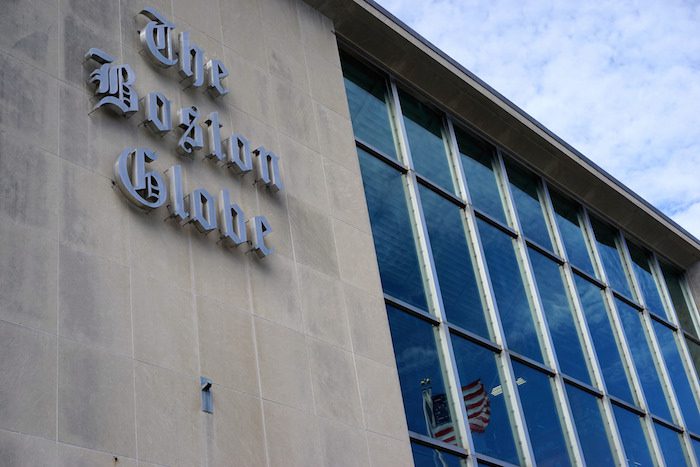
The Boston Globe on Monday published a memo from editor Brian McGrory outlining the latest steps the paper is taking to restructure its newsroom as it adjusts to the evolving journalistic landscape.
The Globe plan focuses on publishing stories earlier in the day, restructuring beats, creating new audience engagement and express desks, and thinking of print as its own distinct platform, not the dominant driver of all workflows.
“None of the changes detailed here will come as any surprise, though in total, they represent significant change,” McGrory wrote:
The basic goals are familiar as well: to be more nimble, more innovative, and more inclined to take worthwhile risk; to get our best journalism in front of readers when and where they want to read it, throughout the day and across all our platforms; to be relentlessly interesting, jettisoning any sense of obligation in our report; to once and for all break the stubborn rhythms of a print operation, allowing us to unabashedly pursue digital subscriptions even while honoring the many loyal readers who subscribe to the physical paper.
Indeed, the changes are the latest indication that American metro newspapers are coalescing around a relatively unified vision for the future.
Over the past two years, newspapers such as The Dallas Morning News, the Miami Herald, and the Minneapolis Star Tribune have all enacted similar initiatives. (Poynter’s Kristen Hare has done a great job reporting from these newsrooms and covering the changes.)
The Star Tribune has a Quick Strike team to cover breaking news and report stories that play well on social media. The Herald staff is working to use analytics and data more effectively to understand its readership. The Morning News moved its morning news meeting from 10:30 a.m. to 9 a.m. Each of those will sound familiar to those reading the Globe’s plans.
The Minneapolis, Dallas, and Miami dailies have participated in the since-renamed Table Stakes project, a $1.3 million Knight Foundation-funded project that launched in 2015 and brought together the Morning News, Star Tribune, and Herald, along with the Philadelphia newspapers, to work together to reimagine their processes and share best practices. In February, Knight and the Lenfest Institute for Journalism — the nonprofit that owns the Philadelphia dailies and was started by H.F. “Gerry” Lenfest — announced that they were renaming the project as the Knight-Lenfest Newsroom Initiative and adding $4.8 million in funding over three years to increase the number of participating newsrooms. The Lenfest Institute is led by Jim Friedlich, the CEO of Empirical Media, a consulting firm that was acquired by the Institute and worked with many of the newsrooms that are involved.The goal is to have 16 newsrooms participating in the project by 2019. The Seattle Times, San Jose Mercury News, Houston Chronicle, and Milwaukee Journal Sentinel are set to join this year.
“The more we saw success in the areas where we just started doing something, the more confidence we gained that we could actually turn things around,” Star Tribune senior managing editor Suki Dardarian told Ken Doctor in February. “I think for so long in this industry, those of us in the newsroom have felt powerless to change anything. It was all about the decline in advertising, and we just had to stand by as witnesses. But in every newsroom I’ve been in, I think the journalists have always wanted to participate in helping the business succeed, and maybe they just didn’t know how, or we couldn’t connect folks from department to department. There is this well of desire in the newsroom to help the business succeed. Now we’re finally able to do things because the model is shifting towards the subscriber. That’s our sweet spot. So what can we do, using metrics, to understand our audience more and to engage them more?”
All of these reinvention efforts are rooted in a better understanding of audiences. Metro newspapers are becoming more reliant on direct reader revenue as print advertising disappears and digital advertising increasingly becomes the domain of Facebook and Google.
A reliance on reader revenue is, of course, the strategy The New York Times has very publicly declared as its path to success. But while the Times has about 1.5 million digital subscribers around the world, metro newspapers have a much smaller audience to draw upon. The Globe has more than 70,000 digital subscribers, the most of any metro newspaper.The privately held Globe doesn’t report its financials. However, A.H. Belo, which owns the Morning News, is a public company, and reported $66.1 million in revenue in the fourth quarter of 2016 — a 9.6 percent drop from the year before. But on a conference call with investors last month, CEO Jim Moroney said “first-quarter 2017 revenue trends compare favorably with the revenue trends we saw in the first nine months of 2016.”
So while the Globe is in a better position than most metro newsrooms, McGrory’s memo emphasized the need to craft coverage that is indispensable to its audience and ultimately convinces them that the journalism is worth paying for.
“We’re going to be more humorous, god dammit, and absolutely more humane,” McGrory wrote. “Boston is a big and fascinating place filled with savvy, often funny, and occasionally brilliant people. We need to reflect this even more, tap into it, and be part of it.”